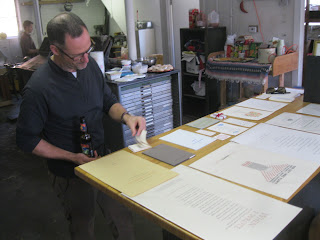A look at the press log tells me it's been a busy November. Projects have come in with a satisfying steadiness: a house number, a pair of wedding invitations, portable signage for a rare book dealer. But as these jobs exist now in various stages of production, I'm glad to be able to send out some invoices. Actually, for the same job twice. My friends Darrell and Elisabeth Hyder of Sun Hill Press/Brookfield Paperworks have long collected alphabets in various media: calligraphed, letterpressed, grandchild-crayonned, etc. They have always wanted one in stone and decided to commission one from me to help give my fledgling operation a boost. They mentioned the project to friends of theirs, the parents of their son's wife, who were so impressed with the idea that they decided to commission one for themselves. I would later learn from Nick--too late!--that the John Stevens Shop, and by implication any self-respecting lettercarver, never carves the same alphabet twice. Given the family relationship between the clients, it seemed only appropriate however that the alphabets bear a family resemblance. Cut from the same slab of Italian slate, the two 11x17" stones do have some subtle differences. They were carved by hand after all. Here they are moments before the big reveal:
These are the second and third inscriptions I have finished with gold leaf. It's a messy, expensive and time-consuming process, where timing is as important as technique. The oil-based adhesive size has a drying window of about three hours, at least theoretically. Its sensitivity to climate conditions can make that window a lot shorter. As I have learned the hard way. These alphabets required multiple attempts to get good coverage. That meant a lot of waiting and hoping and resizing and regilding. Fortunately I had enough gold leaf on hand to get the jobs done. Now let's clean them up.
I may have mentioned elsewhere that this is the one stage where magic seems to sneak into the process. I don't think I'll ever get tired of seeing gilded or painted letters emerge from the shimmering slurry wash.
Once the alphabets are washed and dried, the oiling can begin. With a combination of boiled linseed oil and Japan drier, the stones are rubbed and polished with a high-thread-count cloth wrapped twice around a block of hardwood. This process will both protect the stone from fading and heighten the contrast between the surface and the gilded inscription. Halfway home:
It is not required, but at the end of the month-long process of designing, carving, gilding and oiling an alphabet stone it is recommended that you celebrate with the votive beverage of your choosing. In my case I enjoyed one of the last Pumpkinheads of the 2012 sipping season. Cheers.
Now the stone is ready for delivery. The following morning I drove out to North Brookfield to visit the Hyders, do some typesetting for a printing project and render the official unveiling of their alphabet.
I will have to go back to photograph the stone hanging in place once the Hyders find a home for it. Only six months have passed since I carved my apprentice alphabet at the end of my stay in Newport. It's quite remarkable to me the differences in letter forms as ideas represented as they are in these two attempts. My perception grows keener as my hand gets smarter, a wonderful relationship, hand and eye. Though I am rather proud of these alphabets, I have a lot of new information to take into the next commission. Fortunately I won't have long to wait to apply what I've learned. New projects beckon.


















































